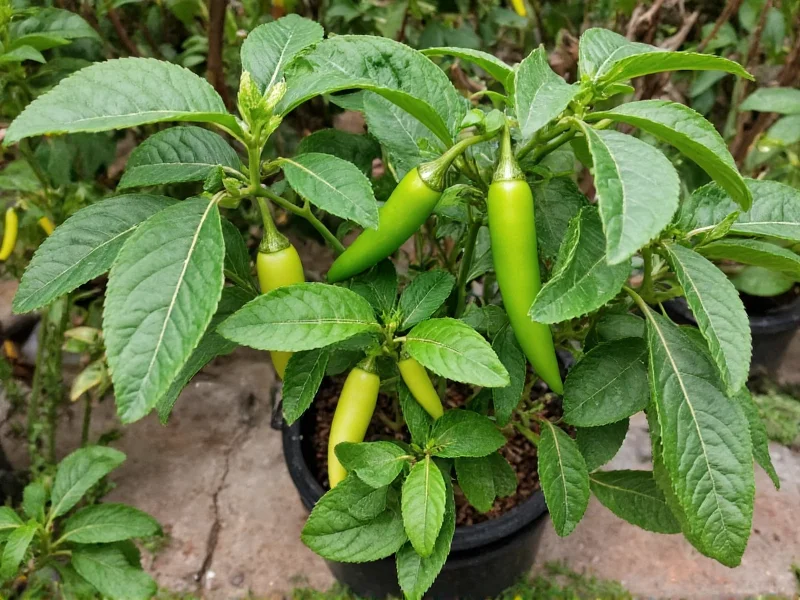Understanding the difference between pasilla and poblano peppers is essential for authentic Mexican cooking and proper recipe execution. Many home cooks and even some grocery stores mistakenly use these terms interchangeably, leading to unexpected results in dishes. This confusion primarily stems from inconsistent labeling practices and regional naming variations.
What Exactly Are Poblano and Pasilla Peppers?
The poblano pepper (Capsicum annuum) is a mild to medium-heat chili pepper that's harvested while still green and fresh. It has a rich, earthy flavor with notes of tobacco and a Scoville heat range of 1,000-2,000 units—milder than a jalapeño. When roasted and peeled, poblanos develop a deep, complex flavor that makes them ideal for chiles rellenos, mole sauces, and stuffing.
Contrary to popular belief, pasilla peppers are not dried poblanos. Pasilla (chile pasilla) refers specifically to the dried form of the chilaca pepper, which is a different variety altogether. The name "pasilla" means "little raisin" in Spanish, referring to its dark, wrinkled appearance and sweet, fruity flavor when dried. Fresh chilaca peppers are long, thin, and dark green, quite different from the broad-shouldered poblano.
| Characteristic | Poblano Pepper | Pasilla Pepper |
|---|---|---|
| Botanical Name | Capsicum annuum (Poblano variety) | Capsicum annuum (Chilaca variety, dried) |
| Physical Form | Fresh green pepper | Dried pepper (dark brown to black) |
| Shape | Broad, heart-shaped, 4-6 inches | Long, thin, wrinkled, 6-8 inches |
| Heat Level | 1,000-2,000 SHU (mild) | 1,000-2,500 SHU (mild to medium) |
| Flavor Profile | Earthy, slightly bitter when fresh | Smoky, raisin-like, berry notes |
| Dried Form Name | Ancho pepper | Pasilla (already dried) |
| Common Uses | Chiles rellenos, rajas, fresh salsas | Mole negro, adobo sauces, stews |
Why the Confusion Between Pasilla and Poblano Exists
The primary reason for the widespread misconception that pasilla and poblano are the same comes from inconsistent labeling practices, particularly in the United States. Many grocery stores and even some recipe developers incorrectly label dried poblanos as "pasilla," when they should be called "ancho" peppers. This mislabeling has perpetuated the confusion for decades.
In Mexico, the distinction remains clear:
- Poblano: Fresh green pepper from Puebla region
- Ancho: Dried poblano pepper ("ancho" means wide)
- Chilaca: Fresh long, dark green pepper
- Pasilla: Dried chilaca pepper
When shopping for authentic Mexican ingredients, understanding this difference between pasilla and poblano peppers becomes crucial for recipe success. The flavor profiles differ significantly—poblanos offer a fresh, vegetal quality while pasillas provide deep, smoky-sweet notes essential for certain traditional sauces.
Can You Substitute Pasilla for Poblano (and Vice Versa)?
Understanding whether pasilla and poblano are the same directly impacts substitution possibilities in cooking. Since they're different peppers in different forms (fresh vs. dried), direct substitution isn't straightforward:
Using fresh poblano instead of pasilla: You'll need to use more poblano to achieve similar flavor intensity, and the dish will lack the characteristic smokiness of dried peppers. Consider adding a small amount of smoked paprika to compensate.
Using pasilla instead of fresh poblano: This creates a more significant flavor shift. Rehydrate dried pasilla peppers first, but recognize you're introducing smoky, raisin-like notes that fresh poblanos don't have. This works better in sauces than in dishes where fresh pepper texture matters.
For the most accurate substitution when a recipe calls for pasilla but you only have poblanos: dry the poblanos yourself to make authentic ancho peppers, then use them in place of pasilla with appropriate adjustments to quantity.
Practical Tips for Cooking with These Peppers
When working with either poblano or pasilla peppers, proper preparation enhances their unique qualities:
- For fresh poblanos: Roast over open flame or under broiler until blackened, then steam in a covered bowl for 10 minutes before peeling. This develops their signature flavor for chiles rellenos or rajas con crema.
- For pasilla peppers: Remove stems and seeds, then toast lightly in a dry skillet before rehydrating in hot water for 15-20 minutes. This process unlocks their complex flavors for mole sauces.
- Storage: Fresh poblanos keep for 2-3 weeks in the refrigerator crisper drawer. Dried pasilla peppers maintain quality for 6-12 months when stored in an airtight container away from light.
When following recipes that specify either pepper, always check whether they're referring to the fresh or dried form. Many authentic Mexican recipes use the dried forms for complex sauces while relying on fresh peppers for stuffing or quick cooking applications. Recognizing the difference between pasilla and poblano peppers ensures your dishes achieve the intended flavor profile.
Identifying Authentic Products
To avoid the common confusion between pasilla and poblano peppers when shopping:
- Look for "chilaca seco" or "pasilla" on dried pepper packaging—not "dried poblano"
- Authentic pasilla peppers should be dark brown to black, very wrinkled, and about 6-8 inches long
- Dried poblanos (anchos) are wider, heart-shaped, and typically reddish-brown
- Fresh poblanos are large, dark green, and have thick walls
Specialty Mexican markets and reputable online spice retailers are more likely to use correct labeling than mainstream grocery stores. When in doubt, ask the store manager about their sourcing practices to ensure you're getting the correct pepper for your recipe needs.











 浙公网安备
33010002000092号
浙公网安备
33010002000092号 浙B2-20120091-4
浙B2-20120091-4